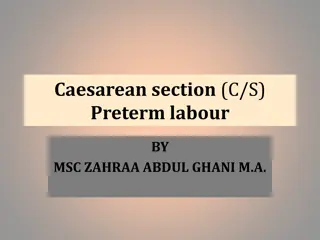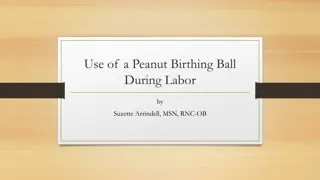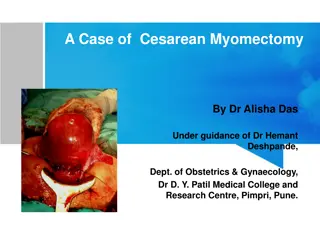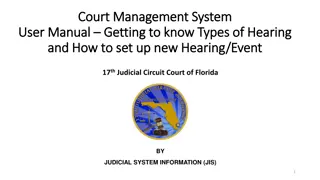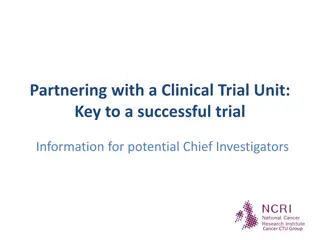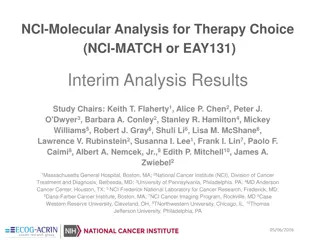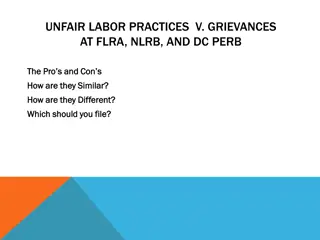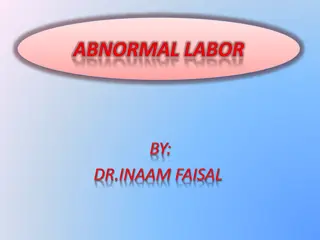Understanding Trial of Labor After Cesarean (TOLAC) for VBAC Success
Explore the historical evolution of Vaginal Birth After Cesarean (VBAC) and Trial of Labor After Cesarean (TOLAC), including counseling patients on risks and success rates, labor management, complications, and strategies to prevent the need for a TOL. Delve into key milestones from ACOG encouraging TOL in 1984 to the NIH VBAC Conference in 2010. Understand the importance of institutional readiness for emergencies during VBAC attempts.
Download Presentation

Please find below an Image/Link to download the presentation.
The content on the website is provided AS IS for your information and personal use only. It may not be sold, licensed, or shared on other websites without obtaining consent from the author. Download presentation by click this link. If you encounter any issues during the download, it is possible that the publisher has removed the file from their server.
E N D
Presentation Transcript
Trial of Labor After Cesarean Carrie Griffin DO May 3rd, 2017
Objectives Review the historical course of VBAC How to counsel patients regarding risks of TOLAC and likelihood of successful VBAC Labor management of TOLAC and its complications Preventing the need for a TOL
To start. Marisa is a 26 yo G3 P2002 at 26 wks based on a 7 wk US who is interested in TOLAC
Brief History In a 1916 article entitled Conservatism in Obstetrics Edward Cragin famously writes once a Cesarean section, always a Cesarean By the 1970s, with the advent of blood transfusions, perioperative antibiotics, a shift in surgical practice, EFM, fewer vaginal breech births and fewer instrumented deliveries led to a higher CS rate of 16.5% by 1980
1984 ACOG encourages TOL 1988 ACOG states that the concept of repeat Cesarean birth should be replaced by a specific indication for a subsequent abdominal delivery 1996 McMahon et al study in NEJM suggests VBAC riskier than initially surmised
VBAC-lash McMahon et al NEJM 1996
ACOG 1999 VBAC Opinion Because uterine rupture may be catastrophic, VBAC should be attempted in institutions equipped to respond to emergencies with physicians immediately available to provide emergency care
NIH VBAC Conference 2010 Found that increase in perinatal mortality from TOLAC is small and comparable to the perinatal mortality rate observed among laboring nulliparous women Increased rates of placenta previa and invasive placentation in women having a third cesarean There are not enough anesthesia providers to ensure immediate availability to all labor & delivery units
NIH VBAC Conference 2010 Voiced concern about barriers to VBAC and recommended that hospitals, providers, insurers and patients collaborate to develop services and strategies to mitigate existing barriers Asked for ACOG to revisit its immediate availability recommendation
ACOG 2010 Practice Bulletin When resources for immediate Cesarean delivery are not available, the College recommends that health care providers and patients considering TOLAC discuss the hospital s resources and availability of obstetric, pediatric, anesthetic and operating room staffs. Respect for patient autonomy supports that patients should be allowed to accept increased levels of risk, however, patients should be clearly informed of such potential increase in risk and management alternatives.
Which of these women is not a candidate for a TOLAC? a) Woman with twin pregnancy and 1 prior CS b) Vertical skin incision c) BMI of 48 d) Classical uterine incision e) Woman with a history of pre-eclampsia and 2 prior CS
ACOG 2010 TOLAC Eligibility NO TOLAC IF Classical or T incision Extension of incision into contractile portion of uterus Full thickness myomectomy OK IF 1 or 2 prior LTCS Twins with single prior LTCS > 40 wks Macrosomia Prior low vertical incision Unknown uterine scar
Marisa is a 26 yo G3 P2002 at 26 wks based on a 7 wk US who is interested in a TOLAC
Prior obstetric history Request and review prior operative report Counsel regarding risks and benefits of TOLAC Understand what local hospital capabilities are Sign TOLAC consent prenatally Continue to readdress decision with patient if change in risk factors, when presents in labor and throughout labor process
Neonatal Risk of TOLAC Landon et al NEJM 2004 study of 17,000 + women which reviewed neonatal outcomes of HIE and death HIE occurred in no infants whose mothers underwent ERCS and in 12 infants whose mothers had a TOLAC 7 of these 12 were following uterine rupture 2 neonatal deaths
Maternal Advantages Avoid major abdominal surgery Lower rates of hemorrhage, infection Shorter recovery time
Neonatal Advantages Vaginal birth associated with less respiratory distress of the newborn, greater likelihood of early initiation of breastfeeding and skin to skin contact
Risks of multiple cesareans Placenta previa Placenta accreta Severe adhesive disease Bladder and bowel injury Emergency hysterectomy
The best predictor of a successful VBAC is a) Really, really wanting one b) BMI < 30 c) Hispanic d) Spontaneous labor e) History of a prior VD
Predictors of Success Increased Likelihood Decreased Likelihood Prior vaginal birth before or after CS No prior vaginal deliveries Admitted in active labor Labor induction Fetal weight < 4000 gm Macrosomia Prior Cesarean for second stage arrest Prior Cesarean for nonrecurring cause (previa, breech) BMI < 30 Obesity Non-hispanic white Hispanic or African-American
VBAC Scoring Systems 74% success rate Individual factors usually still leave women in 60-80% success category unless she has had a prior vaginal birth Grobman nomogram most commonly used
Grobman nomogram 18 25 no no no no no Calculate
Marisa scores a. Predicted chance of VBAC: 81.9%
If she had not had a prior VD Predicted VBAC now 65.1%
And if Marisa were not Hispanic Predicted VBAC success now 90.1%
Risk Stratification for Uterine Rupture Type of uterine incision Multiple prior cesareans Interval since last cesarean # layers of uterine closure
Uterine Rupture Rate Based on Type of Incision Classical Incision 4 9% T or J Incision 4 9% Low vertical incision 1 -- 7% Low transverse incision 0.2 1.5%
Risk of multiple cesareans Landon et al study in 2006 4 year observational study of 45,000 + VBAC 0.9% rate of rupture with multiple CS 0.7% rate of rupture with 1 prior 66% successful VBAC with multiple CS 74% success rate with 1 prior Higher risk of transfusion and hysterectomy if multiple CS
Cesarean Interval Interval of < 6 months between Cesarean and conception shown to have an odds ratio of 2.66 for uterine rupture
Uterine Closure Technique Mixed data but 2014 meta-analysis of 14 studies did not show a difference in uterine rupture rates between single and double uterine closures
Called by the junior night float resident and learn that Marisa is having contractions every 3- 4 minutes and is 6 cm and being admitted for labor
Intrapartum Management Type and screen all TOLAC patients IV access Continuous fetal monitoring Immediate availability of surgeon, anesthesia and OR staff Routine use of IUPC with or without oxytocin usage does not decrease uterine rupture rates
Which of the following should be avoided in labor induction or augmentation in TOLAC patients? a) Pitocin b) Foley bulb c) Misoprostol d) Evening primrose oil e) Nipple stimulation
TOLAC Induction Avoid elective induction No misoprostol unclear if other prostaglandins carry same risk Balloon catheters + slow pitocin Continue to readdress risks & viability of successful VBAC throughout induction
Marisa is now 8 cm and you head in to the hospital. When you arrive her strip looks like this:
Diagnosis of Uterine Rupture Sudden and constant pain Vaginal bleeding Loss of uterine contractions Elevation of presenting part Typically however fetal distress seen first on EFM (70% of cases this is initial indication)
Management of Uterine Rupture Fetal resuscitation techniques still apply including prompt delivery of fetus which may necessitate CS Ensure adequate IV access, neonatal providers available Some evidence that best neonatal outcomes occur if delivery occurs within 17 min of fetal distress appearing on monitor
Tracing improves and now has only intermittent late decels and moderate variability. Marisa is complete and pushes for 80 minutes to deliver a viable female with Apgars of 8 and 9
Prevention for Stage 1 of Labor Strict adherence to definitions for AOL Latent labor 24 hours of Pitocin after AROM Active labor 4 hours of adequate contractions + IUPC and pit 6 hours of inadequate contractions + IUPC and pit
Prevention for Stage 2 of Labor Again adherence to definitions of AOL 3 hours of pushing for primiparous 2 hours of pushing for multiparous women Longer durations acceptable if epidural analgesia in use and if progress is being documented hourly Manual rotation of fetal occiput for malposition Operative vaginal delivery
Key Practice Points Eligible if 1 or 2 prior LTCS Success difficult to predict but generally between 60 to 80% Most major complications occur when TOLACs end in RCS No misoprostol/prostaglandins; Foley/pitocin only The practice of evidence based labor management can help prevent the primary CS




